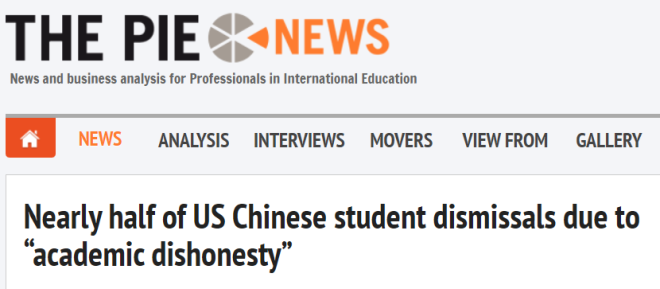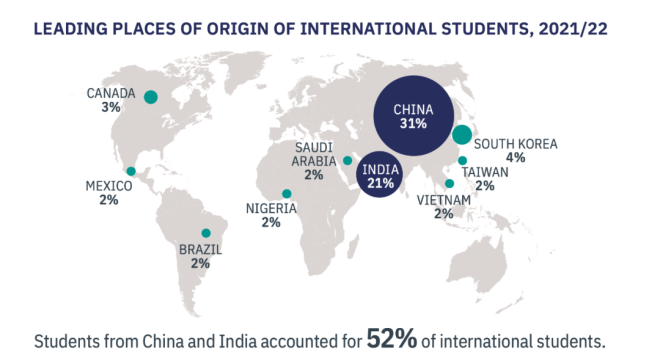The most notable form of this academic dishonesty in the report is plagiarism
风萧萧_Frank
以文会友Sep 6, 2023, Nearly half of US Chinese student dismissals due to “academic dishonesty”
https://thepienews.com/news/academic-dishonesty-common-reason-dismissal-chinese-intl-students/#:~:text=
Nov 14, 2022, US: "soaring" enrolments as international totals approach pre-pandemic levels
https://thepienews.com/news/open-doors-data-2022/?
多伦多大学“读不下去” 学费贵作业多考试难 中国留学生退学率吓人
2023年10月19日 加拿大留学生问吧 作者:51.CA 伍沐
随着加拿大各大高校开学一个月,并且经历了期中考试以后,有不少学生都在网络吐槽:读书难啊、读不下去!
中国留学生聚集的多伦多大学自然是首当其冲!

学生们表示“读不下去”的原因也各不相同。
有人表示是学费太贵,也有人表示考试太难了,还有一些同学表示是因为作业太多,每次都要写到深夜!

除了一些吐槽想退学的学生以外,还有一些学生遭到学校的劝退,原因也各有不同,例如学术不诚信、违反校规等等……
中国留学生名校退学率高达25%
9月25日,美国联邦学历认证中心发布了一份报告:《大学毕业:联邦和各州报告》。

报告中指出,在2022年全美大学中,有大概40%的学生无法在6年内毕业。
而目前,中国留学生占全美留学生数量的31%,但本科退学率居然高达25%。

因此该报告称,中国留学生群体中已经是 学霸和学渣高度并存!
当地媒体The Pie援引 《关于中国留学生被劝退及后果白皮书 (The white paper on Chinese international student dismissal and its consequences)》指出:在2022年3月到2023年3月期间,遭到劝退的中国留学生中,学术不诚信的人最多,占比47.9%;其次是学术表现差,占比46.3%;随后两个原因分别是行为不当和违反校规,分别占比3.2%和2.6%。
而涉及“学术不诚信”的学生 都是出现了以下一个或多个行为:代考、作弊、抄袭、代写、造假、篡改成绩。
学术不诚信行为中最多是抄袭。
2022年至2023年,因学术不诚信而被开除的学生中,有53.8%是因抄袭而被开除的。根据数据,这一问题在2022年3月至2023年3月之间显著增加,增加了近10%。
其他的约28.6%的人因作弊被劝退,7.8%的人因代写被劝退,而3.9%的人因代考被劝退。
这份白皮书报告收集了11,096名学生的数据。其中约1,120起劝退发生在2022年3月至2023年3月期间。其中本科生占69.4%,硕士占26%,博士生占2%。
超过一半的劝退情况发生在美国排名第1至第50位的学校中。
各位留学生们,你觉得现在读书难吗?你有没有过打退堂鼓的想法?欢迎留言交流啊!
但是无论如何,千万不要尝试文中提及的那些“小把戏”!
Nearly half of US Chinese student dismissals due to “academic dishonesty”
by Sophie Hogan
The report from Pittsburgh-based WholeRen Education, which helps “promote Sino-US education opportunities”, found that 47.9% of those students are dismissed due to academic dishonesty.
The white paper on Chinese international student dismissal and its consequences also indicated that poor academic performance was close behind as a reason, citing 46.3% of dismissals.
WholeRen compiled data from 11,096 students whose data sets were complete. Some 1,120 of those occurred from March of 2022 to March of 2023, and 1,000 of those were randomly selected for the report.
It comes as Chinese students are somewhat under a microscope, with geopolitical tensions between the US and China rising and declining Chinese student numbers, according to 2022’s Open Doors data.
WholeRen writes in the white paper that, despite academic dishonesty being the major reason for dismissals, it’s not simply a case of someone cheating – many factors come into play.
The white paper divided intentional dishonesty when students knowingly and purposely violate rules and unintentional behaviour when students have a “lack of understanding of the academic integrity policies in American schools”.
The most notable form of this academic dishonesty is plagiarism. From 2022 to 2023, 53.8% of students dismissed due to academic dishonesty were dismissed as a result of plagiarism.
The issue increased significantly in 2023, jumping almost 10% between March 2022 and March 2023, according to WholeRen’s data.
“Improper use of citation frequently caused Chinese international students to violate academic integrity policies. If students are not familiar with how and when to use citation, it can easily be labelled academic dishonesty – albeit unintentionally,” the white paper points out.
Some 28.6% of this group were dismissed due to cheating, 7.8% due to ghostwriting – aka contract cheating for assignments where someone else is paid to take assignments – and 3.9% due to proxy-test taking.
One student mentioned as a case study in the white paper, named as Student B, reportedly did not “manage his study time properly and found himself struggling” with deadlines – and ended up plagiarising online content to make them.
Despite receiving a job offer, the student still hasn’t actually graduated – the situation “remains in flux”, the white paper said.
“Improper use of citation frequently caused Chinese international students to violate academic integrity”
The intent behind the paper examines just this type of case, where students have difficulty adapting to life in the US due to culture differences.
“It is very likely that the challenges they face will have a negative impact on their academic performance or even lead to behavioural misconduct which, in turn, may lead to warnings or suspension,” the white paper read.
In general data presented by the white paper, 69.4% of the cases were undergraduate, 26% masters and 2% doctoral students.
Around a quarter of those dismissed were in their senior year at a US university – showing that in a good amount of cases, it was only in their last year that issues began to surface.
Over half of the cases were in schools in the US that were ranked one to 50 according to the rankings from US News and World Report.
The rest were evenly split between institutions ranked 50 to 100, and above 100. In terms of location, most schools were either in California or New York – where a good portion of international students in the US flock to.
While academic dishonesty is the biggest dismissal reason, poor academic performance is close behind.
However, again, another factor brought into play is also that not all students in that data set were simply lacking in academic performance – they were also affected by “attendance and psychological problems”.
“Students should seek help as early as possible to explore different options and increase their chances of staying in the US,” the report concluded.
US: "soaring" enrolments as international totals approach pre-pandemic levels
https://thepienews.com/news/open-doors-data-2022/?
Total international student numbers in the US show a healthy near-return to pre-pandemic levels, as new enrolments “soared” by 80% year-on-year, new Open Doors data suggests.
New York was once again the leading state for international students across the US.
The fall snapshot was even more encouraging in its data, with a 9% increase building on the 4% rebound
The 2021/22 academic year data was released on November 14, showing signs of a full-force rebound with a 3.8% increase on last year’s total numbers: 948,519 up from 914,095 in the 2020/21 period.
“As history has shown us, international educational exchange bounces back. And less than two years following the outbreak of the Covid-19 pandemic, student mobility has rebounded,” said Mirka Martel, head of research, evaluation and learning at IIE.
New enrolments showed that numbers jumped a staggering 80% year-over-year with 261,961 students enrolling for the first time versus 145,528 last year.
The fall snapshot data was even more encouraging, with total numbers increasing by 9%, building on the 4% rebound in the 2021/22 data.
“Notably, international student enrolment increases are being reported across all academic levels. This includes undergraduate enrolments at a 2% increase and another significant growth in graduate enrolments at an 18% increase,” Martel reported.
In terms of financial contribution, Open Doors data analysed by NAFSA concluded that international students are contributing an increased amount to the economy – $33.8bn, up by over $10bn from last year’s data.
“[This data] is heartening, but we’re definitely below where we were pre-pandemic in terms of the economic contribution. We do feel there is more to be done,” Rachel Banks, spokesperson for NAFSA, told The PIE News.
Places of Origin
One of the most notable figures from the Open Doors data was the sharp drop in students from China across both undergraduate and OPT – down by 13% and 22%, respectively. While it remained the biggest source country, the totals dropped by 9% from the previous year – and only saw an increase in graduate enrolments, with 4%.
Ethan Rosenzweig, deputy assistant secretary for academic programs at the bureau of educational and cultural affairs at the US Department of State, stressed that despite the figures, China was still a priority for recruitment.
“Health, safety and welfare of all students on US campuses is a top priority. The Biden administration has been very clear that Chinese students are welcome here,” he commented.
“China remains the top sending country with almost 300,000 students on US campuses. Our universities continue to value Chinese students, prioritising recruitment in the PRC and welcoming students on their campuses and in their communities.
“As someone who had two decades of higher education experience, I’m looking forward to the PRC opening its borders for US universities to recruit in-person in the PRC very soon as well,” he added.
On the other hand, India saw one of the biggest jumps in enrolment, increasing by 19% from the previous year – with a total of just under 200,000 students – also possibly down to a staggering 48% growth in graduate students.
“Our universities continue to value Chinese students”
South Korea and Canada, third and fourth respectively in terms of students in the US, also grew by 3% and 7%, respectively.
Large jumps were seen too in students from Germany and Spain, which saw whopping increases of 59% and 41% year-on-year in student numbers, as well as France (37%) and the UK also jumped 28% from the previous year.
Saudi Arabia, like China, saw a large decrease in student numbers, losing 17% from last year’s figures. Vietnam, which had 21,631 students in the US last academic year, saw almost 1,000 fewer students – a 4% decrease.
Academic levels
For the first time in a decade, there were “more [international] graduate students at US universities than there were undergraduates”; likely due to the 17% increase in graduate students, taking the total to 385,097, which also pushed the graduate numbers to higher than pre-pandemic.
“It’s also important to note that we see students recognising that there’s opportunities at all levels of education for them in the US, including the hands-on opportunities to do a graduate degree here,” said Rosenzweig.
“We’re proud that we are still the top destination for international students. And now we see this great hunger for graduate study as well,” Rosenzweig added.
India saw the biggest student numbers in OPT out of any nationality – over a third of the 184,000. While general OPT figures seemed to be slightly down year on year, down 9.4%, Banks is encouraged by the current administration’s approach to the program.
“It’s always at risk if there is a change in the administration that is not friendly toward the program and it remains at risk. We certainly are heartened at the moment that we have an administration that is supportive and has been trying to find ways to make the program work better,” Banks commented.
The fall snapshot also revealed that OPT is now trending up, with a 6% increase.
Programs and funding
In terms of programs taken, for the first time, engineering was overtaken by maths and computer science as the most popular subjects – while engineering saw only a 1% drop, a surge by 10% from the previous year saw maths and computer science take the top spot, with over 200,000 studying it.
Over half of those studying in the US, like last year, were studying in STEM fields.
Seeing a 5% jump was physical and life sciences, which made up 8% of total student numbers – health professions, however, saw a 1% drop from last year, and communications was down over 4%.
“Now we see this great hunger for graduate study”
A sizeable majority of those studying in the US – over 525,500 – were funding their degrees in the country through personal means or with help from family. Another 20% were getting assistance from a US college or university.
Almost 20% of those who were studying were funding their degrees working at the same time, with 187,907 in current employment.
What’s next?
NAFSA also found that for every three international students studying in the US, one job is created – supporting over 335,000 jobs this academic year. Banks told The PIE that even with the student number rebound, the financial contribution continues to lag behind pre-pandemic levels – and action from the government is necessary.
“We still struggle with policymaking in this country as we have not seen changes that would make the US more attractive for international students, such as improved visa processing and immigration law, such as allowing dual intent for F-1 students,” Banks added.
“All of our competitors have, in writing, a strategy for engaging in international education, making it a priority. And it remains, as time passes, glaring that we remain the only major competitive country in the world that does not have a specific strategy for how to advance international education.”






